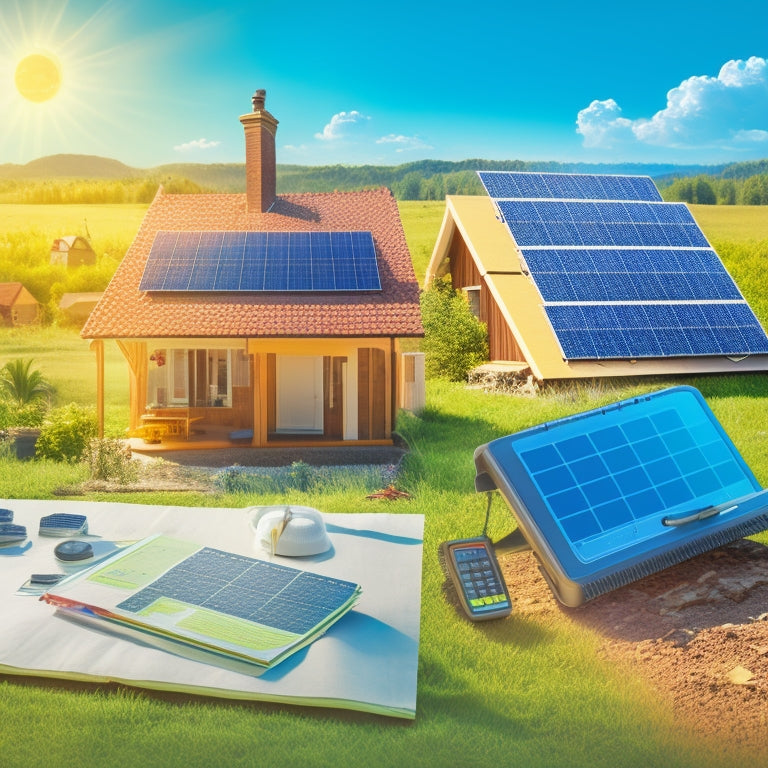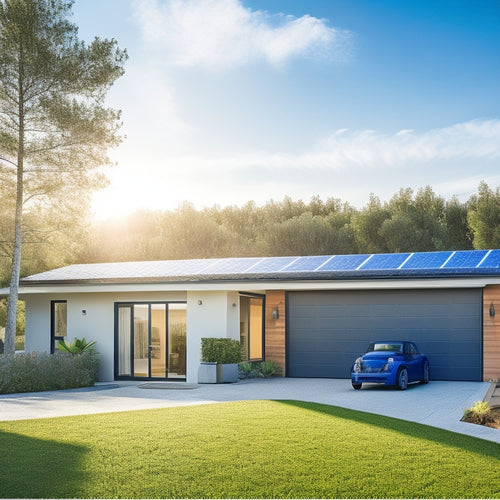
How Much Does Solar Energy Cost Including These 7 Expenses?
Share
When calculating the total cost of solar energy, you'll need to evaluate seven key expenses. System installation costs vary depending on the type and complexity of the installation, while panel quality and quantity affect overall costs and energy output. Your roof's size and condition also impact installation feasibility and energy efficiency. Additionally, you'll need to factor in inverter replacement costs, battery storage expenses, permitting and inspection fees, and ongoing maintenance costs, including panel cleaning and inverter replacements. By understanding these seven expenses, you'll get a clearer illustration of your solar energy investment - and a deeper exploration of each of these factors will help you make an informed decision.
Key Takeaways
- The total cost of solar energy includes upfront installation, panel quality, roof considerations, inverter costs, battery storage, permitting, and ongoing maintenance expenses.
- A comprehensive understanding of each expense category is essential to estimate the overall cost of a solar energy system accurately.
- System installation costs vary widely, ranging from $15,000 to $30,000 or more, depending on system type, complexity, and timeline.
- High-efficiency solar panels and premium inverters increase upfront costs but provide better performance, longer lifespan, and higher energy output.
- Ongoing maintenance, including panel cleaning and inverter replacement, adds $1,000 to $3,000 to the total cost over the system's lifespan.
System Installation Costs
Solar Energy Costs
System Installation Costs
When considering solar energy, you frequently encounter system installation costs as a significant upfront expense. These costs vary depending on the type of system you choose. For instance, rooftop systems are generally more expensive than ground-mounted systems. Additionally, the complexity of the installation process, such as the need for additional electrical infrastructure, can drive up costs.
The installation timeline also plays a vital role in determining the overall cost. A shorter installation timeline typically results in higher labor costs, as the installation team must work more efficiently to meet the deadline. Conversely, a longer installation timeline can lead to lower labor costs but may require additional permits and inspections, increasing the overall cost.
It's essential to understand the breakdown of system installation costs to make an informed decision about your solar energy investment. By considering the type of system and installation timeline, you can better estimate the upfront expense and plan accordingly.
Panel Quality and Quantity
As you plan your solar energy system, the type of panels you select will greatly affect your overall costs.
You'll need to take into account the quality and quantity of panels required to meet your energy needs. High-efficiency panels may be more expensive, but they can generate more power per hour of sunlight, reducing the number of panels you need.
On the other hand, lower-efficiency panels might be more affordable upfront, but you'll need more of them to produce the same amount of energy.
Additionally, you should look into warranty options, which can vary considerably between manufacturers. A longer warranty period can provide peace of mind, but it may also increase the upfront cost.
When evaluating panel quality, take into account factors like durability, temperature coefficient, and certifications.
Top-tier panels often come with premium pricing, but they can provide better performance and longer lifespan.
Roof Size and Condition
Your roof's size and condition play an essential role in determining the suitability of your home for a solar energy system. The size of your roof affects the number of solar panels you can install, which in turn affects the system's energy output. A larger roof allows for more panels, increasing energy efficiency and reducing your reliance on traditional power sources.
The condition of your roof is also vital. If your roof is old or damaged, it may not be able to support the weight of solar panels. You may need to replace your roof before installing a solar energy system, adding to the overall cost.
Additionally, some roof types, such as clay or slate tiles, are more difficult to work with than others, like asphalt shingles. This can increase installation costs and complexity.
When evaluating your roof's suitability, consider factors like age, material, and structural integrity to guarantee a successful and energy-efficient solar energy system.
Inverter Replacement Costs
While evaluating your roof's suitability for a solar energy system, you've likely considered the upfront costs of installation.
However, it's important to also think about the long-term expenses, such as inverter replacement costs.
Inverters are a vital component of your solar energy system, as they convert DC power from your solar panels into AC power for your home. They typically have a lifespan of around 10-15 years, depending on the quality and type of inverter.
Over time, inverter efficiency decreases, and eventually, replacement becomes necessary.
The cost of replacing an inverter can range from $1,000 to $3,000, depending on the type and quality of the new inverter.
It's important to factor this expense into your overall solar energy budget.
Consider the inverter lifespan and efficiency when selecting an inverter for your system. A high-efficiency inverter may be more expensive upfront but can lead to long-term savings and reduce the need for frequent replacements.
Battery Storage Expenses
How much will you need to budget for battery storage expenses when integrating energy storage into your solar energy system? This vital component can greatly influence your overall solar energy costs.
The cost of battery storage largely depends on the type and size of the battery bank you require. A typical battery storage system for a residential solar energy system can range from $5,000 to $15,000 or more, depending on the capacity and quality of the batteries.
It's important to take into account the battery lifespan, which typically ranges from 5 to 15 years, depending on the manufacturer and usage. You'll also want to evaluate the energy efficiency of the battery, as higher efficiency means more usable energy and a longer battery lifespan.
When selecting a battery storage system, look for products with high energy efficiency, a long warranty, and a proven track record of performance.
While the upfront cost may seem substantial, a high-quality battery storage system can provide considerable long-term savings and improve the overall reliability of your solar energy system.
Be sure to factor these expenses into your overall budget to guarantee a thorough and efficient energy storage solution.
Permitting and Inspection Fees
One vital aspect of solar energy costs that often gets overlooked is the permitting and inspection fees associated with installing a solar energy system. As you prepare to utilize the power of the sun, you'll need to factor in these expenses to guarantee a smooth and compliant installation process.
You'll encounter various permit types, including:
- Building permits: Required for structural changes to your property
- Electrical permits: Necessary for connecting your solar energy system to the grid
- Zoning permits: Verify your system complies with local regulations
- Environmental permits: May be required for installations near sensitive ecosystems
- Utility permits: Allow you to connect to the grid and sell excess energy back to the utility company
These permits will trigger inspection processes to verify that your installation meets safety and performance standards.
While these fees may seem minor, they can add up quickly, so it's important to include them in your overall budget.
Ongoing Maintenance Costs
You'll need to factor in ongoing maintenance costs to guarantee your solar energy system operates at peak performance.
These costs include panel cleaning, which can range from $300 to $1,000 per year, depending on the system size and location.
Additionally, you'll need to budget for inverter replacement and system inspection fees, which can add up to $1,000 to $3,000 over the system's lifespan.
Panel Cleaning Costs
As solar panels generate electricity, they inevitably accumulate dirt, dust, and debris that reduce their energy output. This means you'll need to clean them regularly to maintain their efficiency.
The cost of panel cleaning depends on several factors, including the size of your solar panel system, cleaning frequency, and equipment types.
You'll need to take into account the following expenses:
- Manual cleaning: $3 to $10 per panel, depending on the size and complexity of the system
- Automated cleaning systems: $500 to $2,000, depending on the type and quality of the equipment
- Robotic cleaning systems: $1,000 to $5,000, depending on the sophistication of the technology
- Water usage: $50 to $100 per year, depending on the cleaning frequency and water efficiency
- Labor costs: $100 to $500 per year, depending on the frequency and complexity of the cleaning process
Inverter Replacement Costs
In addition to panel cleaning, your solar energy system requires another crucial component to function efficiently: inverters. These devices convert the DC power generated by your solar panels into AC power, making it usable for your home or business. However, inverters have a limited lifespan, typically ranging from 10 to 15 years, depending on the manufacturer and quality.
| Inverter Type | Inverter Lifespan | Inverter Efficiency |
|---|---|---|
| String Inverter | 10-12 years | 95-98% |
| Microinverter | 12-15 years | 90-95% |
| Power Optimizer | 15-20 years | 95-98% |
As your inverter approaches the end of its lifespan, its efficiency will decrease, reducing the overall performance of your solar energy system. Replacing your inverter can cost anywhere from $1,000 to $3,000, depending on the type and quality of the new inverter. It's important to factor inverter replacement costs into your overall solar energy budget to guarantee your system continues to generate power efficiently.
System Inspection Fees
How often do you wonder what it takes to guarantee your solar energy system runs smoothly and efficiently? Regular system inspections are essential to making certain system performance is at its best.
As part of your ongoing maintenance costs, system inspection fees are a necessary expense to prevent issues and identify potential problems before they escalate.
Inspection frequency varies depending on factors like system size, age, and type, as well as local regulations and manufacturer recommendations. Typically, inspections are performed every 6-12 months.
During these checks, certified technicians will:
- Verify system performance and identify any deviations from expected output
- Inspect for signs of wear and tear, damage, or malfunctioning components
- Clean the solar panels to promote maximum energy absorption
- Check electrical connections and wiring for integrity
- Review system monitoring data to identify potential issues
Frequently Asked Questions
Can I Install Solar Panels on a Rented Property?
You'll need to negotiate solar panel agreements with your landlord, considering rental property considerations, such as lease terms and property ownership, before installing solar panels on a rented property.
Do Solar Panels Work During Power Outages?
You'll be glad to know that solar panels don't provide power during outages, but you can invest in backup battery options to store excess energy, ensuring a steady supply when you need it, and maximizing your solar panel efficiency.
Are Solar Panels Environmentally Friendly?
You're wondering if solar panels are environmentally friendly. They are, as they generate clean energy, but you should consider the environmental impact of solar panel manufacturing and the importance of recycling solar panels to minimize waste and emissions.
Can I Sell Excess Energy Back to the Grid?
In a world where ancient Egyptians utilized solar power, you can too! You can sell excess energy back to the grid through net metering options or energy buyback programs, allowing you to offset your electricity costs and even earn credits.
Do Solar Panels Increase My Property Value?
You'll likely see an increase in property value with solar panels, as a property appraisal will reflect the investment returns, increasing your home's worth, and potentially leading to a higher selling price if you decide to sell in the future.
Conclusion
You've done your research and are ready to invest in solar energy, but the question remains: how much will it cost? The answer lies in understanding the seven key expenses involved. Remember, "an investment in knowledge pays the best interest." By considering system installation costs, panel quality and quantity, roof size and condition, inverter replacement costs, battery storage expenses, permitting and inspection fees, and ongoing maintenance costs, you'll be well-equipped to make an informed decision and reap the long-term benefits of solar energy.
Related Posts
-
Trends in Renewable Energy Storage Technologies
You're witnessing rapid advancements in renewable energy storage technologies aimed at improving efficiency and scala...
-

Solar Energy Storage Options for Homes
When considering solar energy storage options for your home, you'll find several effective solutions. Battery systems...
-

Solar Power Advantages for Rural Communities
Solar power presents numerous advantages for rural communities. You can greatly reduce energy costs, potentially by u...

